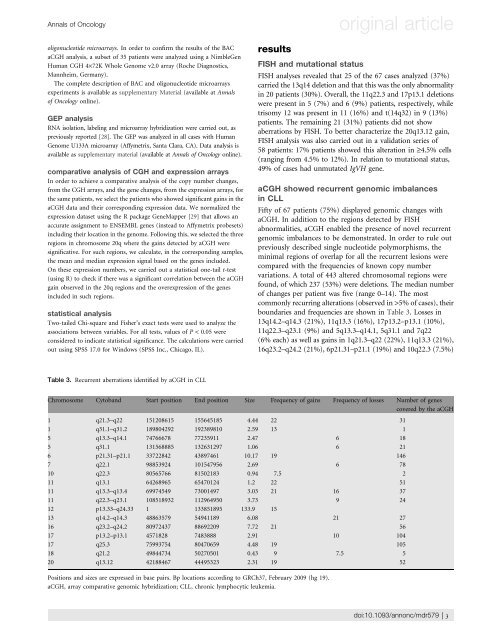Alberto Risueño Pérez - Gredos - Universidad de Salamanca
Alberto Risueño Pérez - Gredos - Universidad de Salamanca
Alberto Risueño Pérez - Gredos - Universidad de Salamanca
Create successful ePaper yourself
Turn your PDF publications into a flip-book with our unique Google optimized e-Paper software.
Annals of Oncology original article<br />
oligonucleoti<strong>de</strong> microarrays. In or<strong>de</strong>r to confirm the results of the BAC<br />
aCGH analysis, a subset of 35 patients were analyzed using a NimbleGen<br />
Human CGH 4·72K Whole Genome v2.0 array (Roche Diagnostics,<br />
Mannheim, Germany).<br />
The complete <strong>de</strong>scription of BAC and oligonucleoti<strong>de</strong> microarrays<br />
experiments is available as supplementary Material (available at Annals<br />
of Oncology online).<br />
GEP analysis<br />
RNA isolation, labeling and microarray hybridization were carried out, as<br />
previously reported [28].TheGEPwasanalyzedinallcaseswithHuman<br />
Genome U133A microarray (Affymetrix, Santa Clara, CA). Data analysis is<br />
available as supplementary material (available at Annals of Oncology online).<br />
comparative analysis of CGH and expression arrays<br />
In or<strong>de</strong>r to achieve a comparative analysis of the copy number changes,<br />
from the CGH arrays, and the gene changes, from the expression arrays, for<br />
the same patients, we select the patients who showed significant gains in the<br />
aCGH data and their corresponding expression data. We normalized the<br />
expression dataset using the R package GeneMapper [29] that allows an<br />
accurate assignment to ENSEMBL genes (instead to Affymetrix probesets)<br />
including their location in the genome. Following this, we selected the three<br />
regions in chromosome 20q where the gains <strong>de</strong>tected by aCGH were<br />
significative. For such regions, we calculate, in the corresponding samples,<br />
the mean and median expression signal based on the genes inclu<strong>de</strong>d.<br />
On these expression numbers, we carried out a statistical one-tail t-test<br />
(using R) to check if there was a significant correlation between the aCGH<br />
gain observed in the 20q regions and the overexpression of the genes<br />
inclu<strong>de</strong>d in such regions.<br />
statistical analysis<br />
Two-tailed Chi-square and Fisher’s exact tests were used to analyze the<br />
associations between variables. For all tests, values of P < 0.05 were<br />
consi<strong>de</strong>red to indicate statistical significance. The calculations were carried<br />
out using SPSS 17.0 for Windows (SPSS Inc., Chicago, IL).<br />
Table 3. Recurrent aberrations i<strong>de</strong>ntified by aCGH in CLL<br />
results<br />
FISH and mutational status<br />
FISH analyses revealed that 25 of the 67 cases analyzed (37%)<br />
carried the 13q14 <strong>de</strong>letion and that this was the only abnormality<br />
in 20 patients (30%). Overall, the 11q22.3 and 17p13.1 <strong>de</strong>letions<br />
were present in 5 (7%) and 6 (9%) patients, respectively, while<br />
trisomy 12 was present in 11 (16%) and t(14q32) in 9 (13%)<br />
patients. The remaining 21 (31%) patients did not show<br />
aberrations by FISH. To better characterize the 20q13.12 gain,<br />
FISH analysis was also carried out in a validation series of<br />
58 patients: 17% patients showed this alteration in ‡4.5% cells<br />
(ranging from 4.5% to 12%). In relation to mutational status,<br />
49% of cases had unmutated IgVH gene.<br />
aCGH showed recurrent genomic imbalances<br />
in CLL<br />
Fifty of 67 patients (75%) displayed genomic changes with<br />
aCGH. In addition to the regions <strong>de</strong>tected by FISH<br />
abnormalities, aCGH enabled the presence of novel recurrent<br />
genomic imbalances to be <strong>de</strong>monstrated. In or<strong>de</strong>r to rule out<br />
previously <strong>de</strong>scribed single nucleoti<strong>de</strong> polymorphisms, the<br />
minimal regions of overlap for all the recurrent lesions were<br />
compared with the frequencies of known copy number<br />
variations. A total of 443 altered chromosomal regions were<br />
found, of which 237 (53%) were <strong>de</strong>letions. The median number<br />
of changes per patient was five (range 0–14). The most<br />
commonly recurring alterations (observed in >5% of cases), their<br />
boundaries and frequencies are shown in Table 3. Lossesin<br />
13q14.2–q14.3 (21%), 11q13.3 (16%), 17p13.2–p13.1 (10%),<br />
11q22.3–q23.1 (9%) and 5q13.3–q14.1, 5q31.1 and 7q22<br />
(6% each) as well as gains in 1q21.3–q22 (22%), 11q13.3 (21%),<br />
16q23.2–q24.2 (21%), 6p21.31–p21.1 (19%) and 10q22.3 (7.5%)<br />
Chromosome Cytoband Start position End position Size Frequency of gains Frequency of losses Number of genes<br />
covered by the aCGH<br />
1 q21.3–q22 151208615 155645185 4.44 22 31<br />
1 q31.1–q31.2 189804292 192389810 2.59 13 1<br />
5 q13.3–q14.1 74766678 77235911 2.47 6 18<br />
5 q31.1 131568885 132631297 1.06 6 21<br />
6 p21.31–p21.1 33722842 43897461 10.17 19 146<br />
7 q22.1 98853924 101547956 2.69 6 78<br />
10 q22.3 80565766 81502183 0.94 7.5 2<br />
11 q13.1 64268965 65470124 1.2 22 51<br />
11 q13.3–q13.4 69974549 73001497 3.03 21 16 37<br />
11 q22.3–q23.1 108518932 112964950 3.73 9 24<br />
12 p13.33–q24.33 1 133851895 133.9 15<br />
13 q14.2–q14.3 48863579 54941189 6.08 21 27<br />
16 q23.2–q24.2 80972437 88692209 7.72 21 56<br />
17 p13.2–p13.1 4571828 7483888 2.91 10 104<br />
17 q25.3 75993754 80470659 4.48 19 105<br />
18 q21.2 49844734 50270501 0.43 9 7.5 5<br />
20 q13.12 42188467 44495323 2.31 19 52<br />
Positions and sizes are expressed in base pairs. Bp locations according to GRCh37, February 2009 (hg 19).<br />
aCGH, array comparative genomic hybridization; CLL, chronic lymphocytic leukemia.<br />
doi:10.1093/annonc/mdr579 | 3
















